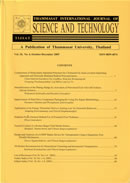ThaiScience
ThaiScience
THAMMASAT INTERNATIONAL JOURNAL OF SCIENCE & TECHNOLOGY
Volume 24, No. 04, Month OCTOBER, Year 2019, Pages 115 - 125
Effects and chemical contents of hydrolysis modification of aqueous roselle extract to reflect the antioxidant and anti-inflammatory effects
Varitha Ariyabukalakorn, Sumalee Panthong, Arunporn Itharat
Abstract Download PDF
Hibiscus sabdariffa (roselle) has been widely used in Thai traditional medicine and food products. However, roselle effects may be unstable under the acidic conditions in the stomach. Thus, the objective of this research was to investigate the stability of bioactivity of roselle extract under acidic conditions. Roselle aqueous extract and acid hydrolysis of roselle extract were assessed for content of phenolic compounds by using Folin-Ciocalteu’s colorimetric method, for antioxidant effect by DPPH radical scavenging assay, and for anti-inflammatory effect by using inhibition of nitric oxide production in RAW264.7 cell line. Five positive marker compounds in roselle extracts (chlorogenic acid, coumaric acid, ferulic acid, quercetin and cyanidin-3-o-sambubiosides) were determined by a modified HPLC method. The results showed that acid hydrolysis of roselle extract showed higher antioxidant activity with EC50 of 14.12±0.92 µg/ml and anti-inflammatory with IC50 of 16.84±3.18 µg/ml than the aqueous extract. Moreover, acid-hydrolyzed roselle extract showed higher total phenolic content than aqueous roselle extract. For HPLC analysis, the acid-hydrolyzed extract contained no chlorogenic acid and cyanidin-3-o-sambubiosides, but levels of the others were higher than for the aqueous extract. The results revealed roselle extract showed higher biological activity and active compounds content after acid hydrolysis.
Keywords
Acid hydrolysis, Roselle, Hibiscus sabdariffaTHAMMASAT INTERNATIONAL JOURNAL OF SCIENCE & TECHNOLOGY
Published by : Thammasat University
Contributions welcome at : http://www.tijsat.tu.ac.th
